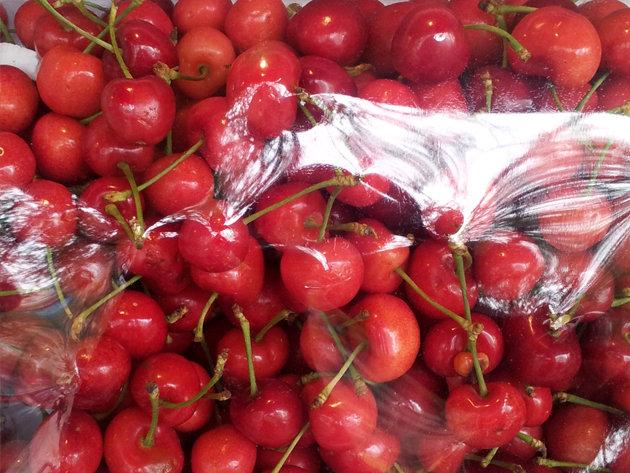Storage and Preservation Technology of “+Double Fresh” “1-MCP” for Cherry
Addtime:2014-09-28 Click:

Attention should be paid to the following links for storage and preservation of cherries:
1. Selection of storable variety: Cherries in China mostly ripen in mid-May and aren’t easily stored and transported due to small fruit, soft fruit and much juice. 90% of amarelle are used for processing. It is of great significance to store and preserve sweet cherries. The early-maturing varieties ripen between late May to early June, cannot be easily stored due to short growth period, thin pericarp and bad fruit density and they can only be stored for a short term after cold processing. The late-maturing varieties ripen in late June, have the compact pulp and can resist the low temperature. Therefore, the varieties which ripen between middle and late June and early July shall be selected for storage and preservation, such as Napoleon, Bingku, late yellow, late red, autumn heart cherry, Schmitt, Tianxiangjin and Tian’an. The newly introduced varieties shall firstly bear the storage test and can’t be stored blindly.
2. Management before picking and harvest time: Pick those ripe fruit which is fully colored but isn’t soften manually and bring the fruit stem during harvest. The fruit cannot be easily stored if it rains 2-3 days before harvest or orchard was irrigated one week before harvest. 0.5% calcium chloride solution shall be sprayed to the trees every seven days 15 days before harvest or liquid preservatives shall be sprayed to the sweet cherry before harvest so as to improve the storability of fruit.
3. Harvest of cherry: The fruit which is used for export sales and storage and preservation shall be harvested when it ripens 80 or 90%. The harvest time shall be determined according to days after booming, pericarp color degree, taste and purpose. In addition, cherries ripen in different degrees because of different periods of fruit setting of inflorescence, so they shall be harvested in batches.
Cherries which are used for storage shall be harvested with fruit stem and shall be handled gently during harvest and transport. After harvesting, firstly select cherries, and then remove fruit cracking, decayed fruit, malformed fruit (conjointed fruit), punctured fruit and mummy fruit. Put those fruits in the lattice wooden box or plastic pass box and put the lining in the boxes so as to prevent the bruising of fruit during transport.
4. Sterilization of cherry: Cherries are easy to have brown rot, gray mold and soft rot (caused by rhizopus nigricans) during storage. To prevent such diseases, sec-Butylamine fumigant can be used to sterilize and 0.1-0.2g of sec-Butylamine fumigant is applied to each kilogram of cherries. When conditioned, 0.1% Thiabendazole, 0.5%ortho-phenyl acid sodium and 0.5% vitamin can be used for soaking fruit to control brown stain and rot.
5. Preservation by “1-MCP”: Cherry is a non-climacteric fruit, but exogenous – ethylene strongly influences the storage of cherries. Under the normal temperature, a little ethylene can accelerate the ripeness and decay of cherries, lead to soft fruit quality, light color and bad taste and shorten the storage life. Therefore, under the low temperature, “1-MCP” shall be used to retain the freshness of cherries so as to greatly extend their storage period, and keep the fruit quality and improve the commodity value. If you use the preservative which is researched and developed by the Company, we will provide the corresponding technical guidance on storage, help customers reach the better storage and preservation effect and create the maximum return for customers.
6. Common methods for storage and preservation: The main methods for storage of cherries include ice cellar storage, refrigeration storage, air conditioned storage and subatmospheric pressure storage. Although these methods can extend the storage period of cherries to an extent, they still have limitations in the actual application. For example, ice cellar storage needs a great number of ice blocks to keep low temperature. It can be easily achieved in the northeast China region, but it wastes labor and hours in Shandong and Hebei. Large-scale refrigeration storage or air conditioned storage are characterized by much energy consumption, slow temperature reduction and greater risk. Therefore, cherries shall be stored in the small-scale automatic refrigeration storage and air conditioned storage.
TZFGZ series automatic refrigeration storages and FACA series flexible air conditioned storages which are researched and developed by Shandong Institute of Pomology should be well recommended. Cherries shall be stored at the temperature of 0±0.5℃. Those cherries which are used for storage shall be immediately put into storage for precooling after being picked to shorten the time from picking to storage. If cherries are immediately packed, transported and stored without being precooled after being picked, the temperature of cherries and of storage environment rises due to field heat, humidity rises and respiratory action of cherries enhances continuously, thus causing heat accumulation and decayed fruit.
The water content of cherries is 80%-90%. To prevent shrinking of pericarp cells due to water loss, cherries can be packed by 0.02-0.05mm thick polyethylene or polyvinyl chloride bags. The capacity of each bag is 1-2kg and doesn’t exceed 5kg at most so as to reduce the water loss of fruit and regulate the gas. Cherries show a low responsiveness to ethylene and don’t require oxygen and carbon dioxide strictly. The concentration of oxygen and carbon dioxide which is suitable for storing cherries is respectively 3%-10% and 10%-15%. 10t and 20t of flexible air conditioned storages (FACA) regulate gas easily and are suitable for delivery of cargo from storage. In addition, there are many sample viewing ports, so the fruit change inside the storage can be observed at any time. Therefore, cherries are best stored in the flexible air conditioned storage.